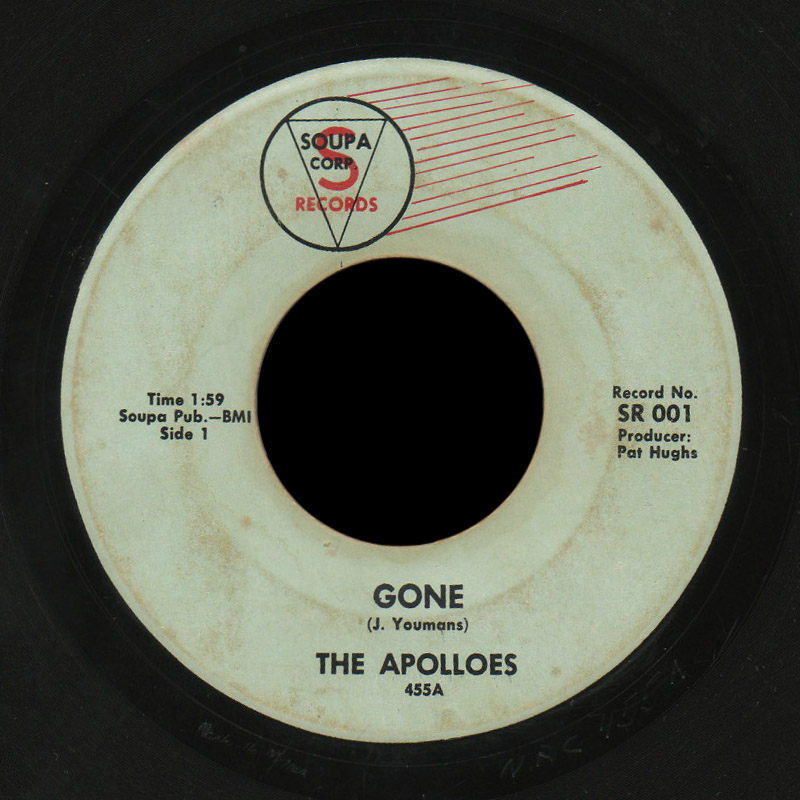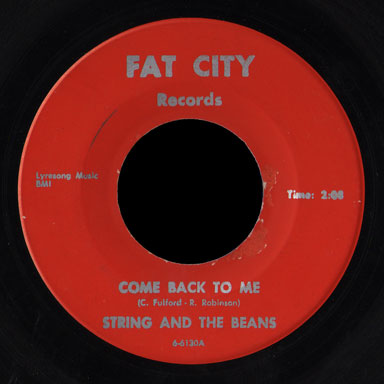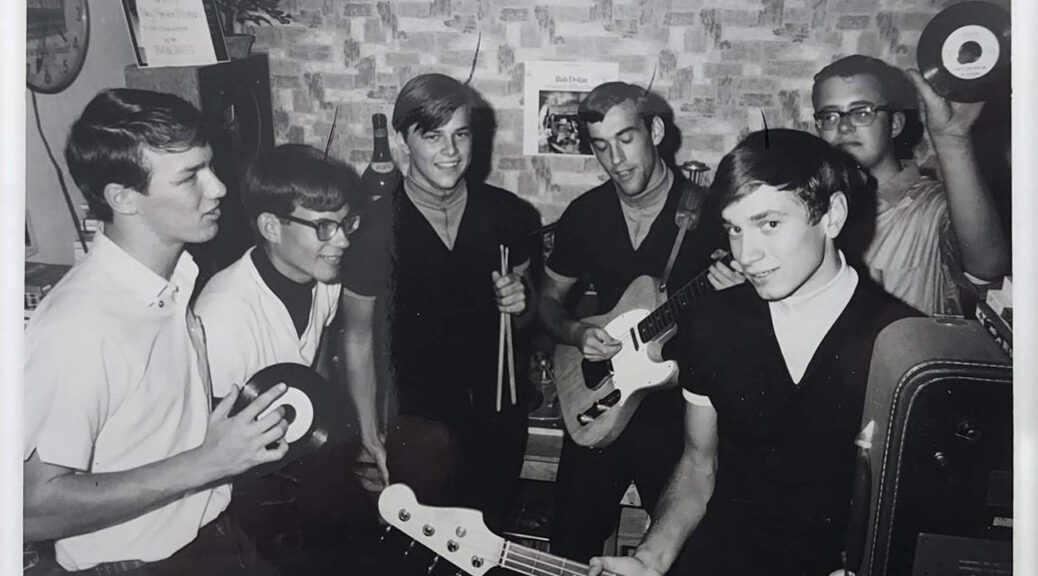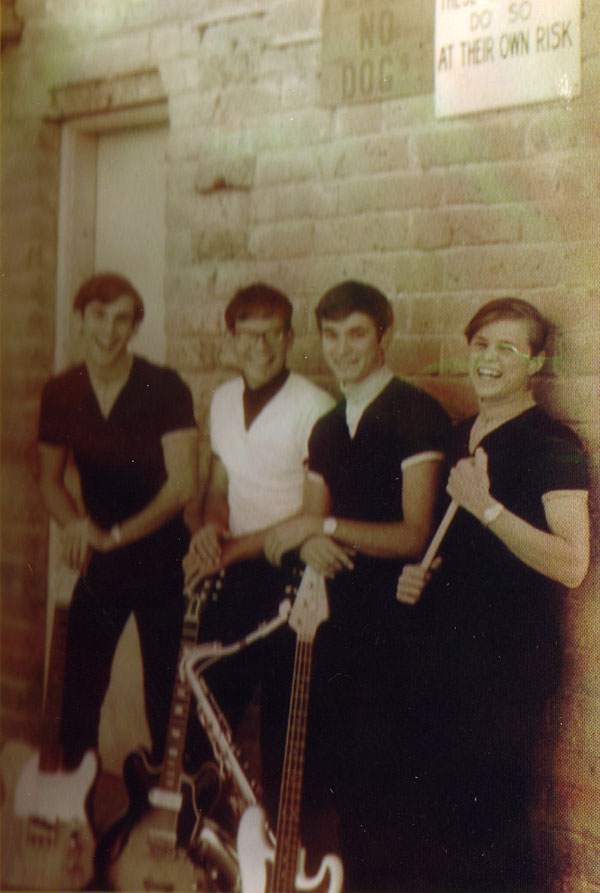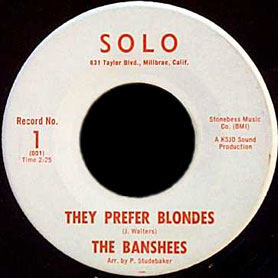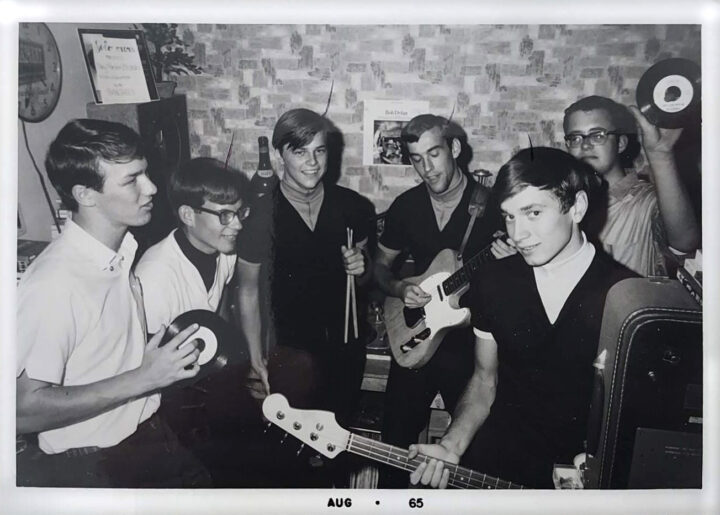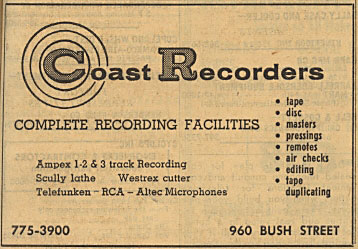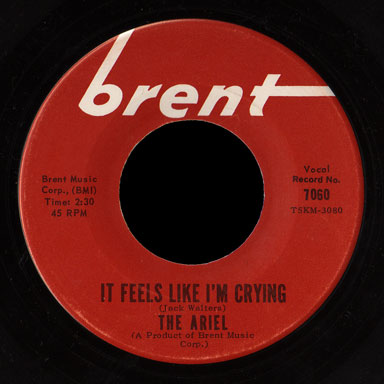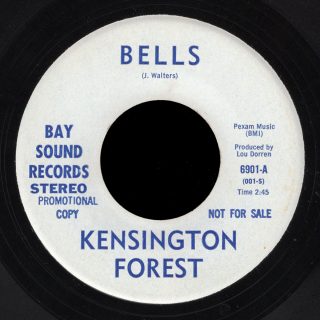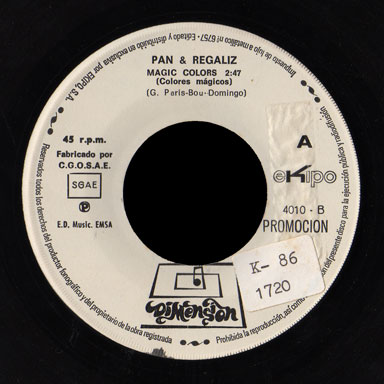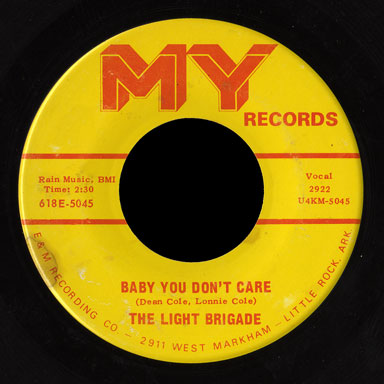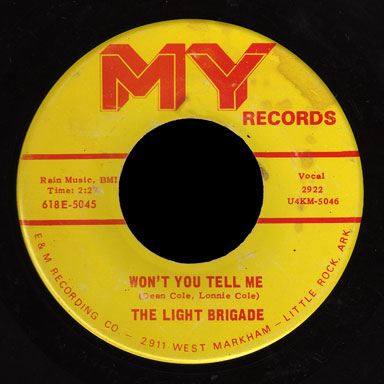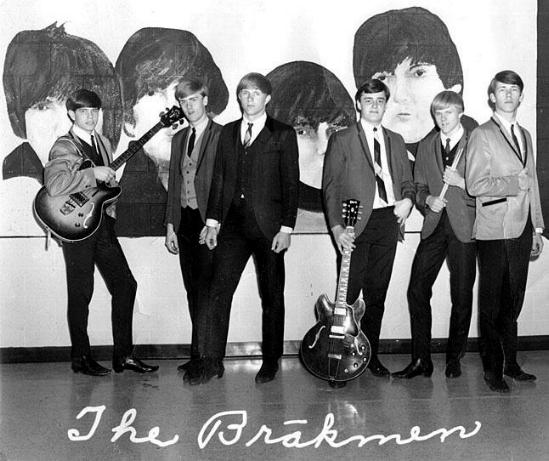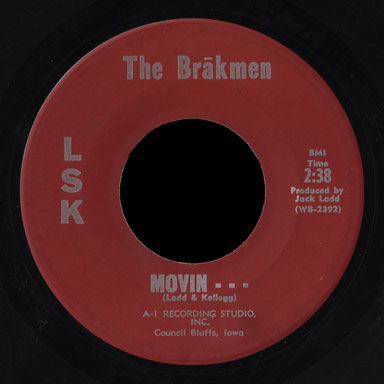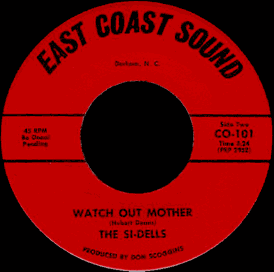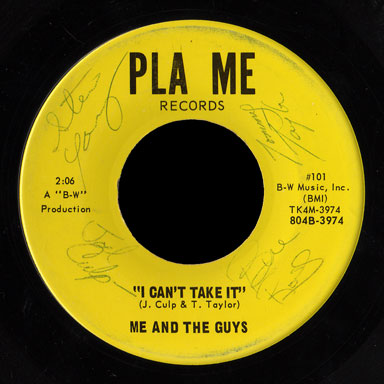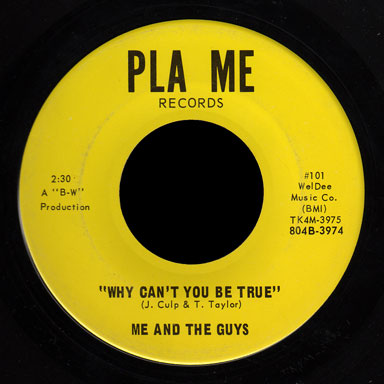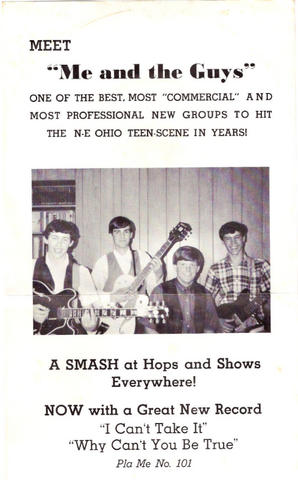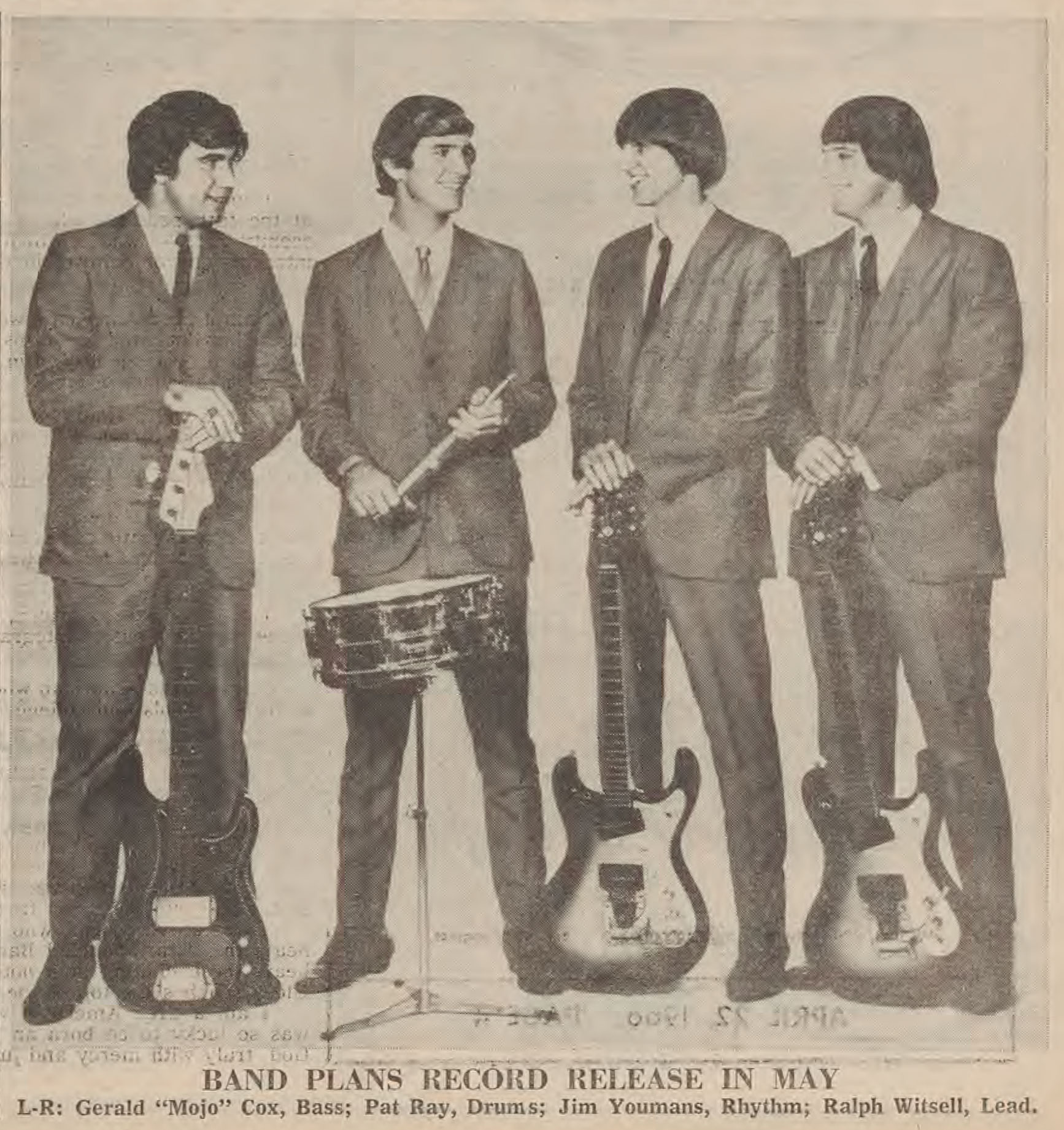
The Apolloes cut an interesting variety of work, from the off-the-cuff and updated renditions of 50’s standards like “Slow Down” and “Summertime Blues” to the intricately produced psychedelia of “Chained and Bound”.
In a comment below, Pat Ray gives the early history of the group:
I founded The Apolloes along with Ralph Whitsell, Jim Youmans and Tom Preston in the fall of 1964 when we were all students at Middle Georgia College in Cochran, Georgia.
The off campus “Animal House” fraternity at Georgia Southern College in Statesboro, Ga (SEX was the name of the fraternity) booked the Rolling Stones in May, 1965. We played as a warm-up band. When the Stones took the stage, they immediately grossed the South Georgia audience out. Jagger’s first word was a long “F***************K You!” The crowd booed them off the stage and began chanting “Apolloes!! Apolloes!!” We set up again and gave the crowd their money’s worth.
Tom Preston wrote in a comment below:
Playing with the Apolloes was great fun. I was still a part of the group at the Rolling Stones concert and will always remember it. Also, James Preston, my brother, sang as the front man and played harmonica for a time with the original group.
Pat Ray continues:
When Tom’s father passed away early, I got hold of Gerald Cox in Atlanta to play bass guitar. He and I had played together for years in Atlanta while we were in high school. The four of us blew the Night Shadows off the stage at Misty Waters in 1965 and we came to the attention of Pat Hughes (WQXI in Atlanta).
By the time of their first record in November 1965, the lineup was:
Ralph Whitsell – lead guitarist
Jim Youmans – rhythm guitar
Gerald “Mojo” Cox – bass
Pat Ray – drums
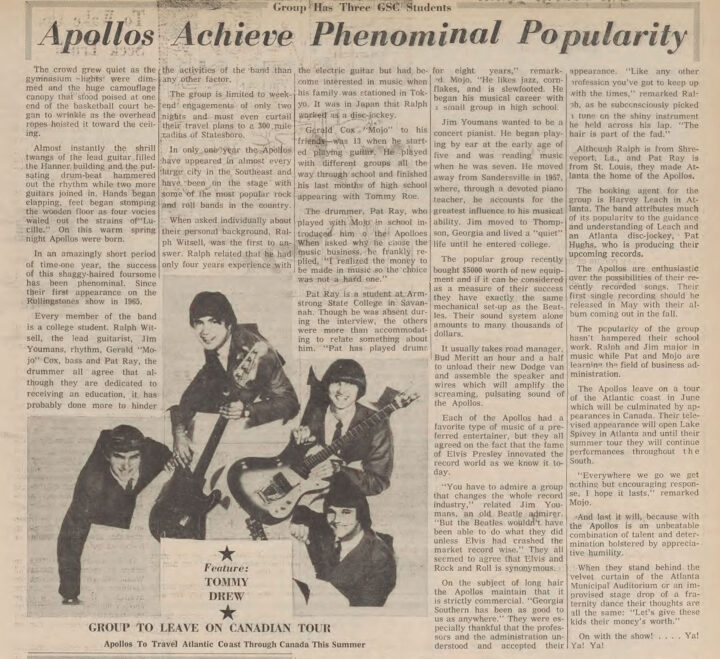
Further info on the early history of the band is in a full-page feature by Tommy Drew in the Georgia Southern College newspaper, The George-Anne on Friday, April 22, 1966:
Apollos Achieve Phenomenal Popularity
Group Has Three GSC Students
… the shrill twangs of the lead guitar filled the Hanner building and the pulsating drum-beat hammered out the rhythm while two more guitars joined in. Hands began clapping, feet began stomping the wooden floor as four voices waled out the strains of “Lucille.” On this warm spring night Apollos were born.
In an amazingly short period of time – one year, the success of this shaggy-haired foursome has been phenominal [sic] … Since their first appearance on the Rolling Stones show in 1965.
Every member of the band is a college student …
The group is limited to weekend engagements of only two nights and must even curtail their travel plans to a 300 mile radius of Statesboro.
Ralph Witsell … related that he had only four years experience with the electric guitar but had become interested in music when his family was stationed in Tokyo. It was in Japan that Ralph worked as a disc-jockey.
Gerald Cox “Mojo” to his friends … finished his last months of high school appearing with Tommy Roe.
Pat Ray is a student at Armstrong State College in Savannah.
Jim Youmans wanted to be a concert pianist … He moved away from Sandersville in 1957 … Jim moved to Thompson, Georgia …
It usually takes road manager Bud Meritt an hour and a half to unload their new Dodge van and assemble the speaker and wires …
Although Ralph is from Shreveport, La., and Pat Ray is from St. Louis, they made Atlanta the home of the Apollos.
The booking agent for the group is Harvey Leach in Atlanta … an Atlanta disc-jockey, Pat Hughs … is producing their upcoming records …
Their first single recording should be released in May with their album coming out in the fall …
The Apollos leave on a tour of the Atlantic coast in June which will be culminated by appearances in Canada. Their televised appearance will open Lake Spivey in Atlanta …
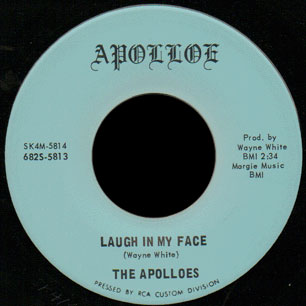 Wayne White, leader of an Atlanta group the Famen happened to be in the studio when the Apolloes came in to play on a session for the Younger Brothers. Wayne taught “Laugh in My Face” to the band and may have played organ on it as well.
Wayne White, leader of an Atlanta group the Famen happened to be in the studio when the Apolloes came in to play on a session for the Younger Brothers. Wayne taught “Laugh in My Face” to the band and may have played organ on it as well.
The flip, “Hey”, was written by Jim Youmans, who produced this single as well as the later “Chained and Bound”.
Gerald had known Wayne White (a house painter in Atlanta) for a number of years. We had booked time at Maurice LeFever’s studio and Wayne paid for the session and we cut “Laugh In My Face.” The flip side was “Hey” by Jim Youmans. Which side was “A” or “B” is a toss-up.
Pat Hughes produced a session at a different studio and we cut “Lucille” and “Gone” which Youmans also wrote. Brooksy Hunicutt sang the high female part at my suggestion and we dubbed it in.
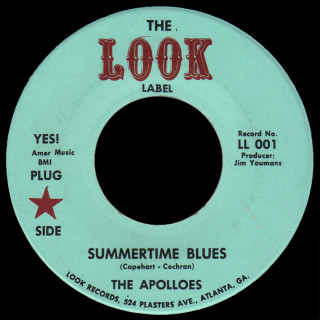 The Apolloes released “Summertime Blues” on three different labels, though the first version on Soupa is not as wild as the one that would come out as the Swingin’ Apolloes. “Gone” the A-side to the first release of “Summertime Blues” was also written by James Youmans, and produced by Pat Hughs.
The Apolloes released “Summertime Blues” on three different labels, though the first version on Soupa is not as wild as the one that would come out as the Swingin’ Apolloes. “Gone” the A-side to the first release of “Summertime Blues” was also written by James Youmans, and produced by Pat Hughs.
After Pat Ray left the band, Randy McDonald took over on drums. Randy commented below, and I’ll repeat much of here:
I had played in a small informal group with Ralph Witsell when I had lived in Macon, but then I had moved to Huntsville, Alabama. He tracked me down when the Apolloes needed a drummer [in 1966]. We were all in school in Statesboro, Georgia that fall and winter, traveling on weekends to gigs.
A journal page I have from then says we went into a recording studio in Atlanta at 7:30 on Friday night, January 13, 1967, and recorded all night, not leaving until 9:30 Saturday morning. That was the “Summertime Blues” session that became the June release.
July 19, 1967, we played the Atlanta Auditorium with the Dave Clark Five on what was billed as Dick Clark’s Caravan of Stars. We had just come from playing the pier at Daytona, if I recall correctly. I know I fell off the drum riser when we were doing our version of “Good Vibrations” because I stood up when I played, and they suddenly doused the stage lights and threw on two strobe lights with a bubble machine right next to me. I was completely disoriented. Our bass player, Mojo (Gerald Cox), was I think about the only person who really noticed, and thought it was hysterically funny. Me, not so much.
We split up in the fall of 1967, primarily because of the war draft and some other issues. I went back to Alabama.
Woody [Turner] was lead singer for a while. I think he had come into the band around the same time they got me to play drums.
The Apolloes single on Look “Summertime Blues” / “Slow Down” was also issued as the Swingin’ Apolloes on White Cliffs 262.
The band had a penchant for backwards guitar, as it’s all over their great version of Larry Williams’ “Slow Down”, and shows up again on their last single as the Swingin’ Apolloes, “Chained and Bound”, written by Chester, Lane and Freeman.
Porcupine commented below: “the backward guitar is also featured on another Jim Youmans production “Go Away” by the Younger Brothers (Wendy 101).
Bill Lane of the Younger Brothers commented below:
I was playing on the Apolloes recording of “Chained and Bound” as one of the three writers and a member of Georgia Southern’s “Younger Brothers” who were recording in Atlanta with Jim Youmans as producer. The entire music track is actually the Younger Brothers with Jim’s voice overdubbed.
45 releases:
The Apolloes – Hey / Laugh in My Face (Apolloe 5813/4, November 1965)
The Apolloes – Gone / Summertime Blues (Soupa 001, May 1966)
The Apolloes – Summertime Blues / Slow Down (Look 001, June 1967)
The Swingin’ Apolloes – Summertime Blues / Slow Down (White Cliffs 262, 1967)
The Swingin’ Apolloes – Chained and Bound / Chained and Bound (SAC 1001-1)
From what I understand, all copies of “Chained and Bound” have the same song on both sides, with a blank label on one side.
This article rewritten in 2022.
Thank you to Mike Markesich for info and Pat W. for the photo below.



